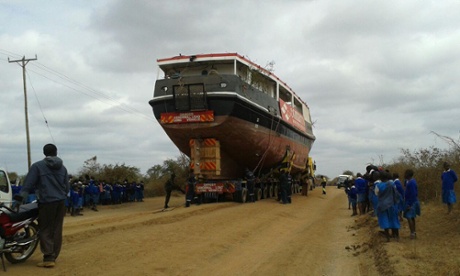
For villagers in rural Kenya, seeing the hull of a 150-tonne ship being hauled along dusty African roads was not an everyday sight. The unusual three-week road trip was the final stage in a 246-day journey which has seen a former Royal Navy tender travel 8,585 miles by sea and land from Scotland to Lake Victoria, Tanzania, where it will serve more than 400,000 people in 150 isolated and impoverished island communities as a medical ship.
The Jubilee Hope, fitted out on the Clyde by BAE Systems, has a full dental surgery, operating theatre, two consulting areas, an eye surgery and a laboratory. It will host life-changing cataract operations, offer a dentistry service and provide help for difficult labours and a range of other healthcare needs.
Getting it there was quite an adventure. As it was impossible to sail to the lake up the dammed river Nile, the only option was to sail down the west coast of Africa, around the Cape, and on to Mombasa, where the top half of the ship was removed to allow it to be towed on a trailer under Kenya’s low overhead power lines.
Volunteers then had to cope with washed-away roads, rebuilding them as they went along.
The vessel – launched by the Edinburgh-based Vine Trust – was then reassembled at the end of its 800km (500-mile) road journey in Kisumu, Kenya, and officially launched on Lake Victoria by the Princess Royal, patron for the charity, this week.
Neil Mungo, 53, an offshore installation manager, was part of a five-strong team of volunteers from oil and gas services company Wood Group PSN who took the vessel apart in Mombasa, then put it back together again on Lake Victoria.
“There was no way it could be sailed up river to the lake as the Nile is dammed, so that is why it was decided to put it on a low loader. They spend a long time planning the route to try and miss any bridges, but there was a problem with the power lines. In order for the boat to be low enough to pass underneath we had to take off anything above deck level, the wheelhouse bridge, the funnel, the masts, generator, crane, the life rafts, handrails, ventilation ports and disconnect all the cable power supplies.
“We marked everything very, very carefully so when it went back together we would know what went where. It took two weeks. I’ve never done anything like that before.”
A different team, from the Kenyan-based marine contractor Comarco, then drove it to Kisumu. “They had to get a team to fill in potholes on the way, and they had to build a section of the road at the end because the rain had washed the road away,” said Mungo. “As it went through the villages, hundreds of schoolchildren would pile out on to the road watching this boat.”
Once it was in Kisumu, Mungo, a former marine engineer, and the other volunteers were helped by Tanzanian workers in the town’s marine yard to reassemble it.
The six-month sea voyage almost stalled at the beginning.
David Heap, 71, a former submariner and member of the Maritime Volunteer Service who was among the crew who sailed from Greenock, said they spent 21 days stormbound in Falmouth six days into the journey. “We had some rough seas throughout,” he said. “Pretty much everyone was seasick.”
Over the next 20 years an estimated 1 million patients, who currently have little or no access to basic medical care, will be seen aboard the ship, which set sail from Glasgow on 22 January.
